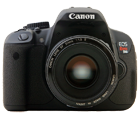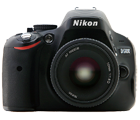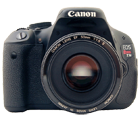DSLR Dynamic Range
You've got a shiny new SLR camera that's packed with digital sensors and electronic light-gathering instruments and yet you're somewhat disappointed with the photos it captures.
Why might that be?
One possible reason is because your digital SLR camera does not have the same dynamic range as your eyes do.
In fact, limited dynamic range is not just an issue with digital SLR cameras - it's been an issue with film cameras for years.
The good news? The latest crop of digital SLR cameras is beginning to address the issue of dynamic range, so that the pictures you take are a better match for how your eyes perceive the world.
Shadows, Highlights and Limited Dynamic Range
Every single photo that you take includes shadows and highlights.
There are a few basic elements that govern the appearance of shadows and highlights in your photos:
- Shadows and highlights become more or less apparent depending upon the level of contrast in the scene
- The level of contrast is determined by the quality of light
- Bright sources of light (bright sunlight, bare bulb flash) create a lot of contrast while muted sources of light (overcast sunlight, diffused flash) generate less contrast
- Light that creates strong contrast is also called hard light while low contrast light is called soft light
- Hard light creates dark shadows and very bright highlights while soft light makes the shadows and highlights more balanced
When you're looking at a scene where there's a lot of contrast your eyes are able to see details in both the shadows and highlights.
A digital SLR camera can't: this is called limited dynamic range.
Since an SLR camera can't capture the entire dynamic range, it has to choose between one of two options:
- Preserve detail in the shadows and over expose the highlights (making them appear pure white)
- Preserve detail in the highlights and under expose the shadows (making them appear pure black)
Let's take a look at the exact same image with each approach applied.
The good news for the computer-savvy out there is that ONE of these problems can be corrected after the fact using image editing software.
Correcting Shadows and Highlights
Many digital images that at first glance appear poorly exposed can often be corrected with image editing software like Adobe Elements.
Unfortunately, there's a catch (assuming that you're saving photos as JPG files, not RAW):
When detail is lost in shadows it can be recovered, but when detail is lost in highlights it's gone for good.
Here's why: when your camera under-exposes shadows in order to preserve detail in the highlights, it actually does capture detail in the shadows. When the shadows are brightened, this detail becomes apparent.
 |
 |
But when highlights are over exposed and appear as pure white in your photo, the image detail in those areas is LOST. There's absolutely no way to re-create the detail even if you reduce the intensity of the highlights.
This is an important point, because it's the key to how some digital SLR cameras enhance their dynamic range.
High Dynamic Range (HDR) Photography
One way to address the problem of limited dynamic range is through the use of software: you create an image with extended dynamic range using a computer not a camera.
The trick with High Dynamic Range (HDR) photos is that they are really 3 or more photos in one.
For any HDR photo, the photographer is blending together more than one image, each with a different exposure.
Let's use an example with three different source images:
| IMAGE # | EXPOSURE | DETAIL PRESERVED |
| 01 | Under Exposed | Highlights |
| 02 | Correctly Exposed | Both Highlights and Shadows |
| 03 | Over Exposed | Shadows |
Image two is the baseline image. Image one is used to preserve highlight detail (the sky is blue instead of white) and image three is used to brighten the shadows (they don't appear as pure black).
Using special HDR software, the photographer merges the three photos — this creates a new composite image where details are preserved in BOTH the shadows and the highlights.
While this is certainly a solution to the limited dynamic range of digital SLR cameras, it's also labor intensive and requires a fairly high level of computer and software expertise to pull off.
The second solution is one that the camera manufacturers are now building in to the cameras themselves.
Extended Dynamic Range
Wouldn't it be nice if - rather than spending hours fiddling around with software - your camera could automatically control the brightness levels of shadows and highlights?
Now they can.
There are several new digital SLR cameras that include enhanced or "extended" dynamic range. I prefer the term "enhanced" myself, since an SLR can't yet extend its range to be equivalent to an HDR image.
Instead, there are two different "tricks" that digital SLRs can use to improve the appearance of images with extreme contrast:
- Make the highlights bright, but prevent them from going to pure white (retain some details)
- Expose for highlights (making the shadows dark) and then increase the brightness of just the shadows to balance the image
The first solution is what you'll find in any Canon digital SLR with enhanced dynamic range - Canon's terms for it is "highlight tone priority".
When highlight tone priority is active, it does just what's described for #1 above: it keeps the highlights in check, and preserves some small amount of detail in bright parts of the photo.
Nikon digital SLR cameras have adopted the second solution: it is dubbed "active D-lighting" (don't you just love these names?).
D-lighting is a feature on older Nikon digital SLRs (like the D80) that lets you to increase the shadow brightness of your photos in the camera - editing the image without having to use a computer.
Active D-lighting is the same concept, the only difference is that the editing takes place at the time of exposure so you don't have to fiddle around with your photos later.
Cameras made by Olympus, Pentax and Sony are also starting to include some form of enhanced dynamic range and yes, they ALL have different names for it.
SPECIAL NOTE: before you get all excited about the prospect of a digital camera that can captures exactly what your eyes see, please realize that this technology is in its infancy, and sometimes the effects are quite subtle.
Unless you know what to look for, it can be quite hard to tell when a camera is compensating for a lack of dynamic range and when it isn't.
And - of course - a feature like this won't make all of your images look stunning. For high-contrast scenes, you'll still have to make some tough decisions about where you want detail preserved.
The important point is that this SLR technology is on the rise, and any feature that makes a camera see the world like our eyes can only be good for future generations of photographers.
Buying Tip
Look for a camera with enhanced dynamic range if:
- You take a lot of photos where there's extreme contrast (bright sunlight)
- You enjoy taking landscape images (where you can't control the light)
Don't be overly concerned about dynamic range if:
- You take photos with artificial lights (where you can control the light)
- You take photos indoors or in the shade (where contrast is low)
- You predominantly take portraits
| Digital SLR Home |

|






